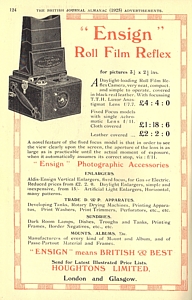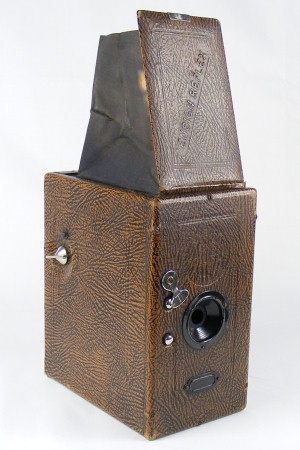Ensign 2¼B Roll Film Reflex
Houghtons Limited
| Name: | Ensign 2¼B Roll Film Reflex |
| Type: | Reflex Camera |
| Manufacturer: | Houghtons Limited |
| Country of Origin: | United Kingdom |
| Construction: | Ensign 2¼B Roll Film Reflex is a very basic reflex built around a conventional box camera design. The top of the camera hinges forwards to reveal the viewing hood, which is held open by a frame. The rear panel of the camera slides out to reveal the film chamber. The shutter is linked with the mirror assembly. |
| Production Period: | 1924 - 1926? |
| Model / Variant: | Brown wood effect cloth covering |
| Plate / Film Size: | 2¼B Ensign roll-film (120) |
| Lens: | Single achromatic f8 (reduced to f11 during exposure) |
| Shutter: | Shutter linked to mirror mechanism (see notes); T & I setting |
| Movements: | None |
| Dimensions (w x h x l): | 8 x 15.5 x 13 cm |
| Date of this Example: | c1925 |
| Serial Number: | None |
| Availability: |
|
| Inventory Number: | 579 |
|
Photos copyright © 2011 David Purcell. Do not use without permission. |
Description
The Ensign 2¼B Roll Film Reflex is a very basic reflex built around a conventional box camera design. The top of the camera hinges forwards to reveal the viewing hood, which has a height of approximately 10cm and is held open by a wire frame (this has come loose from its fixing in this example). The user is then able to view the scene on a ground glass screen by virtue of the internal mirror that receives the image through the taking lens.
According to the BJPA, it has an f8 lens with a stop of f11 that is introduced just prior to exposure. This allows the viewing to be carried out at a wider aperture, with the lens being automatically stopped down during the exposure.
Two finishes were available: a brown simulated wood cloth covering (as here) or black leather (an example of the latter can be seen on the earlyphotography web site, last accessed January 2025). The leather version was sold at the higher price of £2 2s.
The mirror is set by hand using the control on the left hand side of the camera and held in the lowered position against a spring; the mirror trips when the release is pressed. The lens is uncovered when a plate, attached to the mirror, rises in a vertical movement; a second blade follows to complete the exposure.
The name of the camera is embossed in a circle on the front face. It is is marked as "Ensign Reflex" diagonally across the top lid. The rear panel slides out to access the film chamber.
The typically shaped Houghton plate on the front face identifies two patents, namely 210531 & 210717, both dated 1922.
The camera came with the remnants of its original orange box, in a very tatty state. However it still bears the original label identifying the camera by name.
Notes
 |
|
 |
This camera is advertised as the cheaper option for a reflex camera, aimed at the beginner, while the BJPA article states that a "superior model is fitted with a TT & H f/7.7 Anastigmat, has focussing, and is made for horizontal 3¼ x 2¼ in. pictures." This superior model is priced at £4 4s and is pictured in their advert in the same edition of the BJPA. This superior model of the Ensign Roll Film Reflex can be seen here. This camera is listed at a price of £1 18s 6d in an article in the 1925 BJPA (p327), which also shows a line drawing of the camera. It is also introduced in their advert in the same edition (p124), which pictures the superior (and more common) model at the much higher price of £4 4s, as shown on the left. (Click on the thumbnail image to open a larger version in a new window). |
My example carries a price of £1 7s on the box end, suggesting that it must have been sold some time after its initial introduction. Neither the camera or box (what remains of it) identify the maker by name, although the Ensign name appears many times. The 1925 advert is under Houghtons Limited; the equivalent advert in the 1926 BJPA does not show this basic model - only the superior horizontal format camera is listed, but now with several lens options. The BJPA advert of that year also announces the formal merger of Houghtons and Butcher. This leads me to speculate that the camera might have been dropped at that time.
Few examples of this basic reflex camera seem to appear and it is likely that they did not prove that popular. The more expensive horizontal format Roll Film Reflex camera is more common.
Houghtons were not alone in producing these simple reflex viewing box form cameras. Another example in my collection is the Roll-Paff-Reflex made by Ihagee Kamerawerk.
![[ ]](../../images/unchecked.png)
![[x]](../../images/checked.png)








